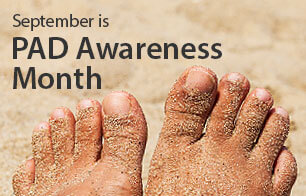Bill Fischer, left, celebrates his 60th wedding anniversary with his wife, Barbara, right, their daughter, Gail McDaniel, and her partner, Keith Hamm. Bill underwent a surgical procedure to treat his advanced peripheral arterial disease.
Knowing the symptoms of peripheral arterial disease (PAD) is not only important for at-risk individuals but also for their family members.
Gail McDaniel, global marketing manager in Aortic Intervention at Cook Medical, knows the importance of PAD awareness when it comes to aging parents. Her father, Bill Fischer, was a lifelong smoker, and smoking is the leading cause of PAD. He developed an ulcer on his foot that continued to worsen. His doctor treated the symptoms but never looked deeper into the cause of the open sore.
When Bill’s foot didn’t heal after several months, he was finally sent to a vascular surgeon, who discovered that Bill had PAD. The ulcer was a result of a 100% occlusion in his superficial femoral artery (SFA), which was blocking blood flow to his lower leg.
“Ironically, he was diagnosed the day Cook received U.S. approval for the Zilver® PTX® Drug-Eluting Peripheral Stent,” McDaniel said. “Unfortunately, he didn’t qualify for a stent, because his disease had progressed too far.” Her father underwent a difficult bypass surgery followed by a long and very painful recovery.
“As we all age, it’s important to be aware of diseases such as atherosclerosis and PAD,” McDaniel said. “By recognizing the early signs of PAD, it’s possible to prevent pain and suffering—or worst case—losing a limb or life.”
Learn more about PAD at the National Institutes of Health website.
MORE ON PAD AWARENESS MONTH
10 facts about peripheral arterial disease
U.S. trends in diabetes and obesity
What is peripheral arterial disease?

Bill Fischer, left, celebrates his 60th wedding anniversary with his wife, Barbara, right, their daughter, Gail McDaniel, and her partner, Keith Hamm. Bill underwent a surgical procedure to treat his advanced peripheral arterial disease.
 Knowing the symptoms of peripheral arterial disease (PAD) is not only important for at-risk individuals but also for their family members.
Knowing the symptoms of peripheral arterial disease (PAD) is not only important for at-risk individuals but also for their family members.
Gail McDaniel, global marketing manager in Aortic Intervention at Cook Medical, knows the importance of PAD awareness when it comes to aging parents. Her father, Bill Fischer, was a lifelong smoker, and smoking is the leading cause of PAD. He developed an ulcer on his foot that continued to worsen. His doctor treated the symptoms but never looked deeper into the cause of the open sore.
When Bill’s foot didn’t heal after several months, he was finally sent to a vascular surgeon, who discovered that Bill had PAD. The ulcer was a result of a 100% occlusion in his superficial femoral artery (SFA), which was blocking blood flow to his lower leg.
“Ironically, he was diagnosed the day Cook received U.S. approval for the Zilver® PTX® Drug-Eluting Peripheral Stent,” McDaniel said. “Unfortunately, he didn’t qualify for a stent, because his disease had progressed too far.” Her father underwent a difficult bypass surgery followed by a long and very painful recovery.
“As we all age, it’s important to be aware of diseases such as atherosclerosis and PAD,” McDaniel said. “By recognizing the early signs of PAD, it’s possible to prevent pain and suffering—or worst case—losing a limb or life.”
Learn more about PAD at the National Institutes of Health website.
This story reflects the experience of one individual. Every peripheral arterial disease case is unique. Information included in this article should not be used as the basis for any treatment recommendation.